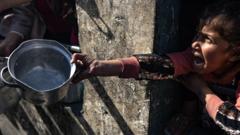A recent report from The Lancet medical journal highlights the significant risks posed by the Trump administration's drastic cuts to U.S. foreign humanitarian aid, potentially leading to the deaths of over 14 million individuals by the year 2030. Among this number, a staggering third is expected to be children, raising alarms among health experts.
U.S. Secretary of State Marco Rubio revealed in March that the Trump administration had reduced funding for more than 80% of the programs at the U.S. Agency for International Development (USAID). According to co-author Davide Rasella from the Barcelona Institute for Global Health, the impacts of these cuts would mirror the toll of a global pandemic or a significant military conflict on low- and middle-income nations.
The report emerges amidst a crucial United Nations-led aid conference in Seville, Spain, where world leaders are convening to address global humanitarian needs. An analysis covering 133 countries showcased that USAID funding has been instrumental in preventing around 91 million deaths in developing countries between 2001 and 2021. However, forecasts suggest that an 83% reduction could reverse these gains, resulting in over 14 million avoidable deaths, including approximately 4.5 million under-five children—amounting to nearly 700,000 child fatalities annually.
This funding cutback initiative is part of a broader agenda led by the Trump administration, which includes efforts to trim federal workforce expenses, erroneously branding USAID as an enabler of liberal enterprises. While Rubio claims that nearly 1,000 programs may still function more "efficiently" through the State Department and Congressional consultation, the ground reality reflects a disturbing trend.
Reports from UN officials indicate severe humanitarian crises such as extreme starvation in Kenyan refugee camps, where slashed U.S. funding has left food rationing at critical lows. At a facility in Kakuma, the dire effects of malnutrition were glaringly evident, with reports of infants showing severe signs of neglect due to lack of nutrition. The outcomes of these funding cuts pose grave concerns for both immediate and long-term health within these vulnerable populations.




















